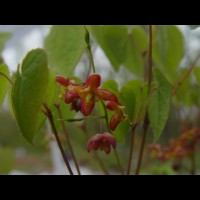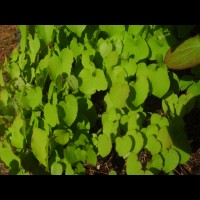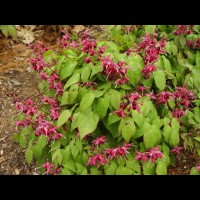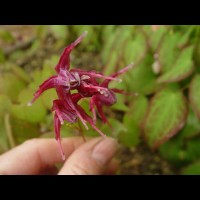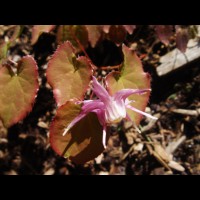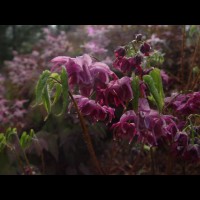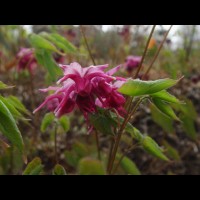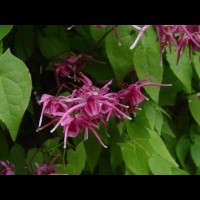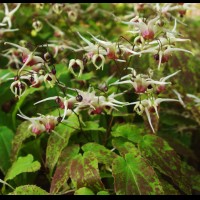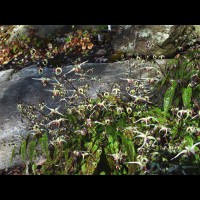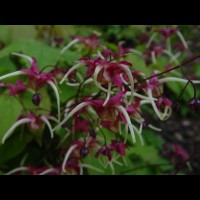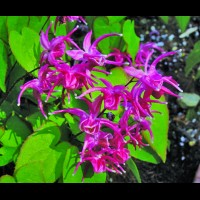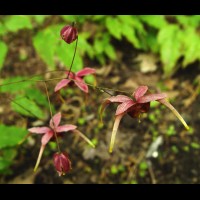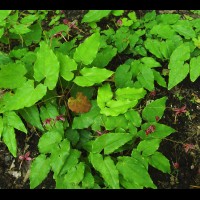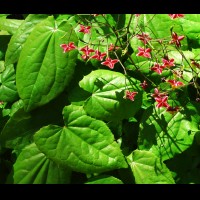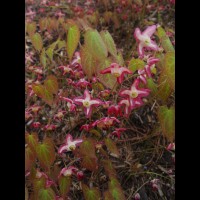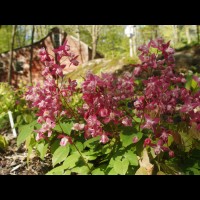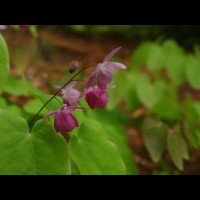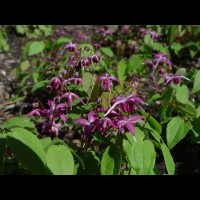Epimedium alpinum
Epimedium alpinum (Cc. 920002)
This drought tolerant spreading species from southern Europe sports very small flowers held below and among medium-sized leaflets. Inner-sepals are red behind creamy-yellow petals/spurs. 12" tall. The leaflets flaunt a complementary thin, mascara-like red edge while the plant is in bloom. Spreads 8-12" a year, forming an open groundcover. Semi-evergreen.
Epimedium alpinum 'Shrimp Girl'
E. alpinum ‘Shrimp Girl’ (Cc. 930006)
The clone ‘Shrimp Girl’ is shorter in height (6-8”) than E. alpinum with shorter rhizomes; spreading only 4-5” a year. Its dense growth habit and thick foliage make it far superior at crowding out weeds. Tiny blooms appear below the leaves and are not usually noticeable unless the plant is elevated on a hillside. A short, neat, ground-covering Epimedium with a "cool" name. Semi-evergreen.
Epimedium grandiflorum 'Circe'
E. grandiflorum ‘Circe’ (Cc. 950244)
***2006 Cobblewood Introduction***
Beautiful large rose-red flowers accented with white spur tips have caught the eye of many a visitor to our open nursery weekends. This cultivar has much the same characteristics to recommend it as Epimedium grandiflorum ‘Yubae’ but with 2-3 times the number of bloom stems held above the foliage, and a shorter stature. Heavily flowered with a slightly darker cast to the young foliage. Medium-sized leaflets form a mound to 13”. An early bloomer hybridized by Darrel Probst.
Epimedium grandiflorum 'Cranberry Sparkle'
E. grandiflorum ‘Cranberry Sparkle’ (Cc. 950162)
***2002 Cobblewood™ Introduction***
Darrell’s friend Don Elick spent five days in April 1995 on a whirlwind dash through southern Japan searching for select forms of wild Epimediums that might prove useful in Darrell’s breeding program. This was his most incredible find with large, rich cranberry flowers held out horizontally on 6” stems. The small leaflets are flushed bronze in spring. Very, very late to emerge and one of the last grandiflorums to bloom. 10” tall.
Epimedium grandiflorum 'Mt. Kitadake Red'
E. grandiflorum ‘Mt. Kitadake Red’ (Cc. 960020)
A darling little plant, beginning its bloom with leaves only 5” tall. The large, rose-red flowers are held above the foliage at 7” high. A second flush of leaflets follows on stems to 10”. Each small leaflet is tinted with bronze to dark reddish-purple in spring. This clone has exhibited pink and yellow fall color in the nursery.
Epimedium grandiflorum 'Orion'
E. grandiflorum ‘Orion’ (Cc. 920020)
A giant “red" flowered Epimedium, probably originating from central Honshu in Japan. Grows 14 to 18” tall at bloom time, with large leaflets, and no second flush of growth. Large violet-red flowers are produced in profusion held below the large, bold leaflets. Flower color reads from a distance in the garden. Named by Dick Weaver.
Epimedium grandiflorum 'Red Queen'
E. grandiflorum ‘Red Queen’ (Cc. 950055)
Harold Epstein bought this imposing plant in Japan many years ago, and nicknamed it “Red Queen”. As far as we can determine, it was not a named cultivar. Large, vivid, rose-red flowers peek out from under huge leaflets that may grow to 6” long/4” wide. The bold fall foliage of this regal Epimedium sometimes turns shades of pink/orange. A second growth flush of red-tinted foliage reaches to 14”. A vigorous, bold-textured choice that makes a substantial clump over time.
Epimedium grandiflorum 'Yubae'
E. grandiflorum ‘Yubae’ (Cc. 920022)
(Synonyms: ‘Crimson’, 'Crimson Beauty’, 'Rose Queen’)
One of my favorites, this plant is often mislabeled as ‘Rose Queen’. It arrived in the west many decades ago, already given the name ‘Yubae’ in Japan, but with only Japanese characters to go by and no translation it was probably soon given an English cultivar name. Incidentally, this same plant suffered a third renaming in the U.K. when another plant, ‘Tama No Genpei’, was going around as ‘Rose Queen’ so it was re-named ‘Crimson Beauty’, perpetuating the confusion.
Yubae’s beautiful large rosy-red flowers have white spur tips. This bright flower color can read from a long distance in the garden. The young foliage, purple-bronze in spring, is only 8” tall at first bloom. A second flush of flowers and foliage reaches 18”. Early bloomer.
Epimedium sempervirens 'Mars'
Epimedium sempervirens ‘Mars’ (Cc. 920035)
A rare, rose-red form of this species, named by Dick Weaver from a plant he purchased from Japan. 6” tall in bloom with a second flush to 10” tall. Medium-sized leaflets. When grown well, ‘Mars’ produces up to 30 or more flowers per stem, forming a dense head. Very showy. Medium/large, dark rose-red flowers. Rusty red/salmon fall color.
Epimedium 'Beni Chidori'
E. 'Beni Chidori' (Cc 050001)
An attractive Japanese variety, given the name "a thousand red-birds chirping' and that is what it truly looks like in bloom- clusters of showy reddish-purple flowers with sepals a lighter shade of the same color. The medium-sized leaflets form a mound of bright green foliage to 10 in bloom, 18-20" high in second growth. Spurs are tipped in white. A very floriferous clone.
Epimedium 'Domino'
Epimedium ‘Domino’ (Cc. 990614)
***2004 Cobblewood Introduction***
Absolutely stunning in the garden-- a true specimen epimedium. Long, showy panicles of creamy white flowers with an abbreviated maroon cup are highlighted against handsome mottled foliage in spring. Elegant elongated spring leaflets are sponge-painted in various shades of maroon. Deep reddish-purple outer sepals and dark purple pedicels. Forms a 12-14" mound of spiky evergreen foliage with soft spines, covered in a halo of long flower stems to 16”. May re-bloom and produce a second flush of mottled new growth to 18" under favorable conditions of humus-rich soil and adequate moisture.
Epimedium 'Flame Thrower'
Epimedium ‘Flame Thrower’ (Cc 990619)
***2009 Cobblewood Introduction***
Cheerful cherry red and creamy yellow flowers dance above the foliage of this hybrid from Darrell Probst. The inner sepals have decorative undulations to their shape, resembling flames licking upwards from the top of the flower. This cross between deciduous and evergreen parent plants gives this hybrid both vigorous growth and deep green, spiny leaflets of good substance. Drought-tolerant.
Epimedium 'Kuki'
Epimedium ‘Kuki’ (Cc. 050002)
Heavy clusters of flowers dripping with deeply saturated color distinguish this beautiful Japanese selection. Numerous full clusters of reddish-purple flowers bloom against a background of fresh spring-green foliage. Each curved spur is tipped in white. A thin red line scribes the edge of each medium-sized new spring leaflet.
Epimedium 'William Stearn'
Epimedium 'William Stearn' (Cc. 150004)
A hybrid from Robin White of the former Blackthorn Nursery in Hampshire, England. As one of the earliest "red" flowering epimediums, it was named for the late William Stearn who wrote the monograph on Epimediums in 1938 (revised in 2002 by Timber Press).
The arrow-shaped, semi-evergreen leaflets form a handsome clump, exhibiting reddish-brown mottling in the spring. Produces short, few-flowered stems of muddy red and yellow flowers. I have found it to be slow to establish in the garden. The foliage is its greatest asset, in my opinion.
Epimedium 'Yokihi'
Epimedium ‘Yokihi’ (Cc. 050030)
An outstanding late-blooming Japanese cross between E. davidii and E. grandiflorum ‘Yubae’, this clumping hybrid produces long arching 18” spikes of large spidery flowers. The dramatic flowers have a flared creamy yellow cup and long, slender spurs backed by short, bright reddish pink inner sepals. Medium green angular leaflets are flushed with bronzy red in spring. Semi-evergreen.
E x cantabrigiense "Red Form"
E. ×cantabrigiense “Red Form” (Cc. 950018)
A tough, slightly-spreading natural hybrid of E. alpinum, which the deeply veined leaves most closely resemble, and E. pubigerum, which the floral sprays most resemble. One of many plants for which we are grateful to Jerry Flintoff, as Darrell has not found it elsewhere in the U.S. This clone was very common in many of the British gardens we visited in April 1998. The sepals are dark red rather than the pale salmon of the clone commonly cultivated in the U.S. Numeroua, small flowers bloom well above the leaves on loosely branched 18” stems. More vigorous than the U.S. form, with larger, medium-sized leaflets. Semi-evergreen.
Epimedium x rubrum
Epimedium x rubrum (Cc. 920042)
Often listed as variety or cultivar of E. alpinum, it is said to be a hybrid between E. alpinum and E. grandiflorum, however the colorful spring foliage could only have come from E. sempervirens ‘Violet Queen’. This slow-spreading hybrid (rhizomes 2-4”) is an excellent groundcover, forming a thick mass of medium-sized leaflets on 16” stems. Foliage flushes cherry-red in spring. The abundantly produced medium-sized flowers have red sepals, creamy-yellow spurs. Commonly referred to as drought-tolerant, but I haven't observed that to be true.
Epimedium x youngianum 'Be My Valentine'
E. x youngianum ‘Be My Valentine’ (Cc. 950231)
***1999 Cobblewood Introduction***
Named in honor of the late Betty Valentine of Berlin, CT, at the request of the CT chapter of NARGS, in celebration of her 90th birthday in1998. Betty loved Epimediums. She grew them most of her life. Covered in bright blooms at only 5-6”, the small-medium-sized flowers have deep rose-pink inner-sepals and white petals flushed rose, with very short, white spurs. Small leaflets. Second growth flush to 14” tall. Early bloomer.
Epimedium x youngianum 'Capella'
E. x youngianum ‘Capella’ (Cc. 920045)
Introduced by Dick Weaver and one of Darrell's personal favorites. This clone has charming dark lavender-rose flowers that are small, simple and produced in profusion above small leaflets for a long period in spring. 8" in bloom with second flush to 10" with some re-bloom.
Epimedium x youngianum 'Ruby Tuesday'
Epimedium x youngianum ‘Ruby Tuesday’ (Cc. 950085)
***2001 CobblewoodIntroduction***
Small and delicate, it begins to bloom at only 5” tall. After a second and third flush of foliage and flowers, it eventually reaches 14”, making it one of the latest blooming of Epimediums. Its small spring leaflets have a purple cast. Medium-sized flowers are rich, ruby-red with lighter pale rose to white spurs.
Epimedium x youngianum 'Sudama'
E. x youngianum ‘Sudama’ (Cc. 970201)
An unusual Japanese cultivar with curious raspberry red, pendent flowers borne below the unfurling leaves. The sepals never open, leaving the flower as a dark, inflated ellipse with slightly lighter shoulders. Large spring leaves flush with a soft red edge that eventually fades to a thin line. Blooms late, on 15” stems.
